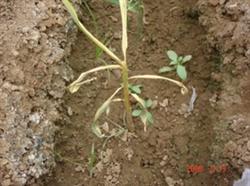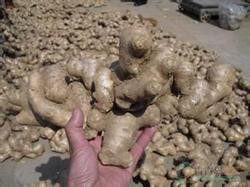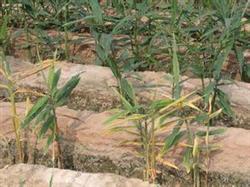Control techniques of diseases and insect pests in ginger

(1), ginger blast 1, pathogen: bacterial disease, Ralstonia solanacearum. 2. symptoms of diseased plants: the leaves were drooping and dull at first, then withered yellow from bottom to top, and finally withered and died. The stem first immersed in water from the base, yellowed, withered, and broke and lodged from the base. The rhizome is immersed in water, browned and rotten, squeezed with white juice, giving off a bad smell. 3. The route of transmission and the law of disease: the pathogen overwintered in the rhizome and soil and survived in the soil for more than two years. Invade from a wound or natural orifice. Germs are spread by growing ginger, soil, fertilizer and irrigation water. 4. Prevention and control methods: (1). Crop rotation: ginger can only be planted at an interval of more than 3 years, and the previous crop is best for food crops or onion and garlic. (2)。 Soil disinfection: Rongxin 12-15kg per mu, spread evenly to the surface, turn deeply, rake flat, drain water, and cover with plastic film. After 20-25 days, the film was opened and turned deeply into the air-drying ground for 10-15 days before sowing. (3)。 Strict seed selection: select ginger pieces with large, bright color, fresh meat, non-drying, non-decay, unfrozen, hard texture, disease and insect pests to grow ginger. (4)。 Land selection and preparation: sandy loam land with high dryness and good drainage. (5)。 Chemical control: A. soak the ginger seeds in 300-fold aqueous solution for 10 minutes before sowing, and spray the ginger seeds and the surrounding soil with 600-fold aqueous solution before sowing. B, after the seedling, one month before the onset of the disease and before and after ridge cultivation, Kangdilide was applied once, with a dosage of 1 kg per mu. C. At the initial stage of the disease, the roots of the plants in and around the disease center were irrigated with the aqueous solution of 75 times of Kangdelaide or 300 times of Longke bacteria or 400 times of Donin, and each plant was injected with 250ml. (2), spot disease 1, pathogen. Half-known subphylum, ginger leaf mold. 2. Symptoms of diseased plant. The main harm to leaves, diseased leaves appear yellow and white spots, thinning in the middle of the spots, easy to perforate, also known as white star disease. 3. The route of transmission and the condition of the disease. Overwintering with mycelium and conidia in diseased remains and soil. Rain Water spread, high temperature and high humidity is conducive to the disease, interplant closure, heavy soil stickiness is serious. 4. Prevention and control methods: rotation of An and 2Mel for more than 3 years. B, select sandy loam land with high terrain and convenient drainage and irrigation. C, balanced fertilization: avoid partial application of nitrogen fertilizer, pay attention to the application of organic fertilizer, phosphorus, potassium fertilizer and trace element fertilizer. D, chemical control: protective agent: Pingrun 800 times or zinc pool 800 times or too prosperous 800 times. Therapeutic agents: Baitai 1500 times or Longke bacteria 500 times or Douning 600 times. Spray 2-3 times at intervals of 7-10 days. (3) anthrax 1 pathogen. Alternaria capsici and Alternaria alternata in the subphylum capsicum. 2 symptoms. Mainly to the leaf, first from the leaf tip and leaf edge appeared water-immersed brown spots, and then into oval or fusiform brown spots, the spot has halo lines. There are small black spots on the diseased face when it is wet. (3) the route of transmission and the condition of onset. Overwintering in diseased body or soil with mycelium and conidia disk. Spread by Rain Water or small insects. Continuous cropping, high humidity and partial application of nitrogen fertilizer are beneficial to the disease. (4) Prevention and treatment. A rotation. B clear the garden after harvest. C balanced fertilization. D stagnant water is strictly prohibited. E, chemical control: 25% fresh gram 1000 times liquid, Kaiser 1250 times, Cuibei 4000 times liquid. (4) ginger albino disease 1. Etiology: underground nematode harm. 2. Control: (1) soil treatment: Longxin (the method is the same as ginger blast). (2) before ridging, ginger was irrigated with Shuangshu 1000 times + avermectin 3000 times. (5) ginger borer. Also known as the heart-drilling bug. 1 symptom. The larvae invaded from the gap between the leaf sheath and the stem or the heart leaf, the leaf was thin, the dung debris remained in the injured place, and the hollow stem was easy to break. (2) Life habits and occurrence regularity. 2-4 generations a year, overwintering with mature larvae on crops and weeds. Generally, larvae began to appear in the first ten days of June and occurred in a large amount from July to August, causing serious harm to the harvest of ginger. 3Prevention and cure. A clear the garden. B chemical control: 1500 times of Julei liquid was sprayed at the beginning of June and sprayed for the second time after 7-10 days. It can also be injected into the aboveground stem insect mouth with the same solution in the first ten days of July. (6) beet armyworm 1. Jiaodong has five generations a year. Winter in the soil with a pupa. two。 Occurrence period: the occurrence period of the first generation larvae in mid-June, and the second generation 20 days later. 3. Spraying control before the 3rd instar of larvae: except for 1500 times, stuck gram 1000 times.
- Prev

Storage technology of ginger
Ginger is a perennial herb of Zingiberaceae. It is not only a commonly used traditional Chinese medicine, but also an important vegetable for export to earn foreign exchange. Due to the wide use and large amount of ginger, coupled with the characteristics of warm and cold, wet and dry, it is particularly important to do a good job of ginger storage and preservation. First, before storage.
- Next

How to effectively control ginger stem rot
In recent years, with the continuous expansion of ginger continuous cropping area and extensive field management, the disease of ginger is also aggravating, especially since June, because of high temperature and rain, ginger stem rot is the most likely to occur. Recently, Li Hualiang and Lu Changlei in Renzhao Town, Pingdu City, Shandong Province, and Yu Wanquan in Ju County reflected that.
Related
- Where is it suitable to grow horseradish in China? it is expected to see the middle altitude horseradish in Alishan.
- How to prevent tomato virus disease reasonably? (Control methods included)
- Many people like to plant towel gourd on the balcony. What are the main points of this method and management?
- What crops can chili peppers be mixed with?
- Fertilization techniques and matters needing attention in Tomato
- What are the grafting techniques for peach seedlings in spring?
- Harm and control methods of root swelling disease of Chinese cabbage
- What are the pests of sweet potatoes? How to prevent and cure it?
- Symptoms, causes and Control methods of navel Rot in Tomato
- The cause of "Cucumber rotten bibcock" in Farmers' planting Cucumber and its Control Plan

